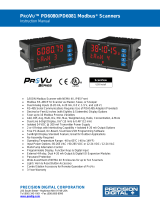4
Setting Up the Displays (dsplay setup) ..................................................... 33
Display Line 1 Parameters (Line 1 dsplay) ............................................. 33
Display Line 2 Parameters (Line 2 dsplay) ............................................. 33
Display Intensity (d-IntY) ........................................................................... 33
Display Line 1 Menu (Line 1 dsplay) ...................................................... 34
Display Line 2 Menu (Line 2 dsplay) ...................................................... 35
Setting the Tags (tAg) & Units (units) ....................................................... 36
Application Example 1 ................................................................................. 36
Application Example 2 ................................................................................. 38
Setting the Relay Operation (relay) ............................................................ 39
Relay Setup Menu (relay setup) ............................................................. 39
Setting the Relay Action (act 1)................................................................. 40
Programming Set and Reset Points ............................................................ 40
Setting Fail-Safe Operation (failsf).......................................................... 40
Programming Time Delay (delay) .............................................................. 40
Relay Action for Communications Break (break) ....................................... 40
Time Delay Operation ................................................................................. 41
Relay Sampling Operation .......................................................................... 41
Relay and Alarm Operation Diagrams ......................................................... 42
High Alarm Operation (Set > Reset) .............................................................. 42
Low Alarm Operation (Set < Reset) ............................................................ 42
High Alarm with Fail-Safe Operation (Set > Reset) ..................................... 42
Low Alarm with Fail-Safe Operation (Set < Reset) ..................................... 42
Pump Alternation Control Operation ........................................................... 43
Relay Operation After Communications Break............................................ 43
Relay Operation Details ................................................................................ 44
Overview ..................................................................................................... 44
Relays Auto Initialization ............................................................................. 44
Fail-Safe Operation (failsf) ...................................................................... 44
Front Panel LEDs ........................................................................................ 44
Latching and Non-Latching Relay Operation .............................................. 44
Non-Latching Relay (Auto) ......................................................................... 45
Non-Latching Relay with Manual Reset (A-nman) ....................................... 45
Latching Relay (LatcH) ............................................................................... 45
Latching Relay with Clear (Lt-Clr) ............................................................ 45
Acknowledging Relays ................................................................................ 45
Pump Alternation Control Applications (Altern) ........................................ 46
Setting Up the Interlock Relay (Force On) Feature ..................................... 46
Scaling the 4-20 mA Analog Output (Aout) ................................................. 47
Setting Up the Password (pass) ................................................................... 48
Protecting or Locking the Scanner .............................................................. 48
Making Changes to a Password Protected Scanner ................................... 48
Disabling Password Protection.................................................................... 48
Advanced Features Menu ............................................................................. 49
Advanced Menu Navigation Tips................................................................. 49
Advanced Features Menu & Display Messages.......................................... 49
Scan Function (SCan) .................................................................................. 51
Manual Control Menu (Contrl)................................................................... 52
Noise Filter (filter) ................................................................................... 53
Noise Filter Bypass (bypass) ...................................................................... 53
Rounding Feature (round) .......................................................................... 53
Select Menu (SELect) ................................................................................. 53
Low-Flow Cutoff (CutofF) ........................................................................... 61
Analog Output Source Programming (aoutpr) ........................................... 61
Programmable Function Keys User Menu (user) ....................................... 63
Digital Input Menu (dI 1) ............................................................................ 64
Digital Output Menu (dO 1) ......................................................................... 64
Reset Menu (reset).................................................................................... 64
Troubleshooting................................................................................................. 65
Diagnostics Menu (diag) .............................................................................. 66
Determining Software Version..................................................................... 66
Reset Scanner to Factory Defaults ............................................................. 66
Testing the Display LEDs ............................................................................ 66
Scanner Operation ............................................................................................. 67




























